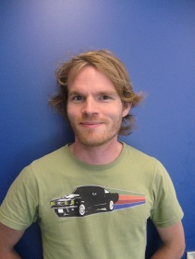Controlling the propagation of light in disordered scattering media
Promotion date: 24 April 2008
Thesis advisor: Prof. dr. Ad Lagendijk
Assistant thesis advisor: Dr. Allard P. Mosk
| A new wavefront shaping technique is developed to steer light through opaque materials. When the shaped wavefront exactly matches the scattering properties of the object, for example white paint or the shell of an egg, the object focuses light to a point. This is done by sending the light through the medium, and changing the wavefront of the incident beam. By recording the intensity in the point where we want to focus the light, one can calculate scattering coefficients, corresponding to the degree of statistical scattering in the sample. An optical device, called a phase modulator, is used to anticipate and correct for the scattering yet to occur on a point-to-point basis. In this way we steered light through opaque objects and even projected simple images. A similar method is used to focus light inside an opaque object. |
How does your work fit in the MESA+ programme?
The research is inspired from topics related to nano electronics. Many of the theoretical concepts were originally developed for scattered electrons. We translated these concepts to nano-photonics, using the propagation of light travelling through complex opaque materials.
Scattering and diffusion of light are huge limitations for optical imaging, but also hinder telecommunication, spectroscopy, and other optical techniques. We delivered a new approach to tackle these kinds of problems.
You can imagine, that if this approach works for complex materials like white paint, it can also be of use in photonic devices and computer chips. The diffusion of light in scattering media is, after this, not an inevitability, and spectroscopy and microscopy can be greatly improvable.
In order to come to this new approach, what kind of challenges did you meet?
Creating spatially shaped wavefronts for this kind of complex materials, is completely new. We influenced light in an extreme way. Using phase- and amplitude-modulating techniques in this case, you encounter experimental and theoretical challenges, influencing each other, time and time again.
Also you have to find solutions at other levels of operating, like computer-bugs, building devices to use in the lab, computer programming, and how to present your work.
Being a scientist is hard work, and involves many facets. These have all to be present inside of you. It is a great feeling when you measure something, at last, that you predicted beforehand.
What are your future plans?
In September I am starting a postdoc in Zürich. It is a bio-project where the early development of fruit flies is under study. A part of my measurement process is suitable for these research activities. In biology a lot of optics is used, and I have a lot of experience concerning all kinds of optics. Using my creativity in this totally new area, I feel, is a good opportunity for me at this moment in my career.

